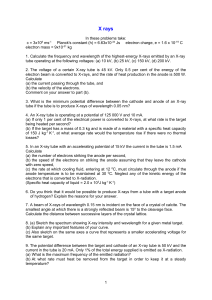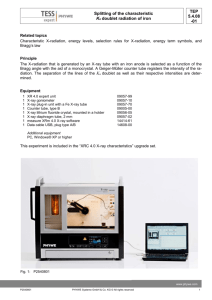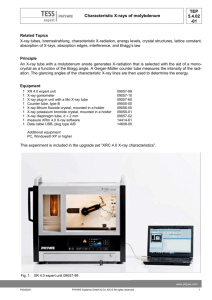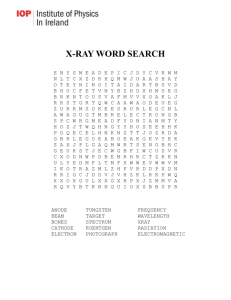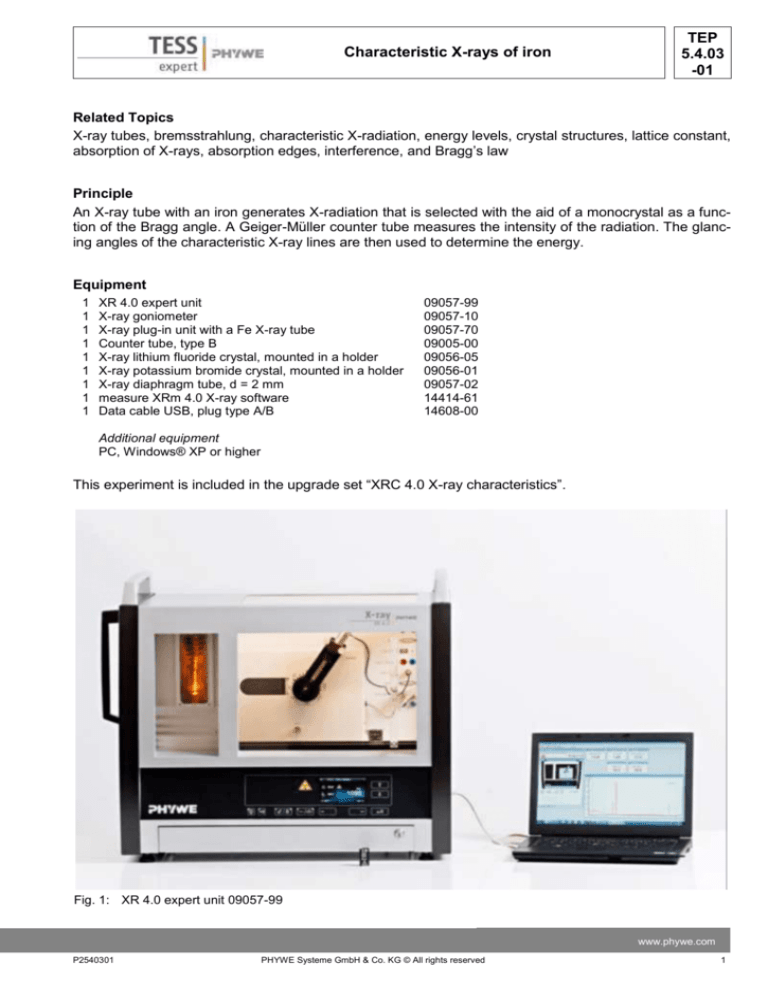
Characteristic X-rays of iron
TEP
5.4.03
-01
Related Topics
X-ray tubes, bremsstrahlung, characteristic X-radiation, energy levels, crystal structures, lattice constant,
absorption of X-rays, absorption edges, interference, and Bragg’s law
Principle
An X-ray tube with an iron generates X-radiation that is selected with the aid of a monocrystal as a function of the Bragg angle. A Geiger-Müller counter tube measures the intensity of the radiation. The glancing angles of the characteristic X-ray lines are then used to determine the energy.
Equipment
1
1
1
1
1
1
1
1
1
XR 4.0 expert unit
X-ray goniometer
X-ray plug-in unit with a Fe X-ray tube
Counter tube, type B
X-ray lithium fluoride crystal, mounted in a holder
X-ray potassium bromide crystal, mounted in a holder
X-ray diaphragm tube, d = 2 mm
measure XRm 4.0 X-ray software
Data cable USB, plug type A/B
09057-99
09057-10
09057-70
09005-00
09056-05
09056-01
09057-02
14414-61
14608-00
Additional equipment
PC, Windows® XP or higher
This experiment is included in the upgrade set “XRC 4.0 X-ray characteristics”.
Fig. 1: XR 4.0 expert unit 09057-99
www.phywe.com
P2540301
PHYWE Systeme GmbH & Co. KG © All rights reserved
1
TEP
5.4.03
-01
Characteristic X-rays of iron
Tasks
1. Analyse the intensity of the iron X-radiation as a function of
the Bragg angle and with the aid of a LiF monocrystal.
2. Repeat task 1 with a KBr monocrystal as the analyser.
3. Determine the energy values of the characteristic X-rays of
iron and compare them with the values that were determined based on the corresponding energy-level diagram.
Set-up
Connect the goniometer and the Geiger-Müller counter tube to
their respective sockets in the experiment chamber (see the red
markings in Fig. 2). The goniometer block with the analyser crystal
should be located at the end position on the right-hand side. Fasten the Geiger-Müller counter tube with its holder to the back stop
of the guide rails. Do not forget to install the diaphragm in front of
the counter tube (see Fig. 3).
Insert a diaphragm tube with a diameter of 2 mm into the beam
outlet of the tube plug-in unit for the collimation of the X-ray beam.
For calibration: Make sure, that the correct crystal is entered in
the goniometer parameters. Then, select “Menu”, “Goniometer”,
“Autocalibration”. The device now determines the optimal positions Fig. 2: Connectors in the experiment
of the crystal and the goniometer to each other and then the posi- chamber
tions of the peaks.
Note
Details concerning the operation of the X-ray unit and goniometer as well as information on how to handle the monocrystals can be found in the respective operating instructions.
GM-counter
tube
Goniometer at
the end position
Diaphragm tube
Counter tube
diaphragm
Mounted
crystal
Fig. 3: Set-up of the goniometer
2
PHYWE Systeme GmbH & Co. KG © All rights reserved
P2540301
TEP
5.4.03
-01
Characteristic X-rays of iron
Procedure
- Connect the X-ray unit via USB cable to the
USB port of your computer (the correct port of
the X-ray unit is marked in Fig. 4).
- Start the “measure” program. A virtual X-ray unit
will be displayed on the screen.
- You can control the X-ray unit by clicking the
various features on and under the virtual X-ray
Fig. 4: Connection of the computer
unit. Alternatively, you can also change the parameters at the real X-ray unit. The program will
automatically adopt the settings.
- Click the experiment chamber to change the parameters for the experiment. Select the parameters as shown in Figure 6 for the LiF crystal. If
you use the KBr crystal, select a start angle of 4°
and a stop angle of 65°.
- If you click the X-ray tube, you can change the
voltage and current of the X-ray tube. Select the
parameters as shown in Fig. 7.
- Start the measurement by clicking the red circle:
-
After the measurement, the following window
appears:
For setting the
X-ray tube
For setting the
goniometer
Fig. 5: Part of the user interface of the software
Select the first item and confirm by clicking OK.
The measured values will now be transferred directly to the “measure” software.
At the end of this manual, you will find a brief introduction to the evaluation of the resulting spectra.
-
-
Note
- Never expose the Geiger-Müller counter tube to
the primary X-radiation for an extended period of
time.
Overview of the settings of the goniometer and
X-ray unit:
- 1:2 coupling mode
- Gate time 2 s; angle step width 0.1°
- Scanning range 4°-80° (LiF monocrystal)
and 4°-65° (KBr monocrystal)
- Anode voltage UA = 35 kV; anode current
IA = 1 mA
www.phywe.com
P2540301
PHYWE Systeme GmbH & Co. KG © All rights reserved
3
TEP
5.4.03
-01
Characteristic X-rays of iron
Fig 6: Settings of the goniometer
Fig 7: Voltage and current settings
Theory
When electrons impinge on the metallic anode of the X-ray tube with a high level of kinetic energy, Xrays with a continuous energy distribution (the so-called bremsstrahlung) are produced. The spectrum of
the bremsstrahlung is superimposed by additional discrete lines. If an atom of the anode material is ionised on the K shell following an electron impact, an electron from a higher shell can take up the free
place while emitting an X-ray quantum. The energy of this X-ray quantum corresponds to the energy difference of the two shells that are involved in this process. Since this energy difference is atom-specific,
the resulting radiation is also called characteristic X-radiation.
Fig. 8 shows the energy level diagram of an iron atom. Characteristic X-radiation that is produced following a transition from the L shell to the K shell is called Kα radiation, while the radiation that is produced
following a transition from the M shell to the K shell is called Kβ radiation (M1 →K and L1 → K transitions
are not allowed due to quantum-mechanical selection rules).
l 1 and j 0, 1 selection rules for the dipole radiation
(l = orbital angular momentum, j = total angular momentum)
Fig. 8: Energy-level diagram of iron (Z = 26)
4
PHYWE Systeme GmbH & Co. KG © All rights reserved
P2540301
TEP
5.4.03
-01
Characteristic X-rays of iron
The characteristic X-ray lines of iron have the following energy levels (Fig. 8):
E K * E K
1
EL 2 EL3 6.3974 keV
2
(1)
EK EK EM 2,3 7.0580keV
EKα* is the energetic mean value of the Kα1 and Kα2
lines.
The analysis of polychromatic X-rays is made possible through the use of a monocrystal. When X-rays of
the wavelength λ impinge on the lattice planes of a
monocrystal under the glancing angle ϑ, the rays that Fig. 9: Bragg scattering on a pair of lattice planes
are reflected on the lattice planes interfere with each
other in a constructive manner provided that their path difference Δ corresponds to an integral multiple of
the wavelength.
In accordance with Figure 9, Bragg’s law applies to constructive interference:
2d sin n
(2)
(d = interplanar spacing; n = 1, 2, 3,…)
If the interplanar spacing d is known, the wavelength λ can be determined with the aid of the glancing
angle ϑ. The energy of the radiation then results from:
E h f
hc
(3)
When combining (2) and (3), we obtain:
E
n h c
2d sin
Planck's constant
Velocity of light
Interplanar spacing LiF (200)
Interplanar spacing KBr (200)
Equivalent
(4)
h
c
d
d
1 eV
= 6.6256・10-34Js
= 2.9979・108 m/s
= 2.014・10-10 m
= 3.290・10-10 m
= 1.6021・10-19 J
Note
The data of the energy-level diagram were taken from the "Handbook of Chemistry and Physics", CRC
Press Inc., Florida.
Evaluation
In the following section, the evaluation of the data is described based on example results. Your results
may differ from the results given below.
Task 1: Analyse the intensity of the iron X-radiation as a function of the Bragg angle and with the aid of a
LiF monocrystal.
Figure 10 shows the X-ray spectrum of iron that was analysed with a LiF monocrystal. Well-defined lines
www.phywe.com
P2540301
PHYWE Systeme GmbH & Co. KG © All rights reserved
5
TEP
5.4.03
-01
Characteristic X-rays of iron
Fig. 10: Intensity of the X-radiation of iron as a function of the glancing angle ϑ; analyser crystal: LiF
are superimposed on the continuous bremsspectrum. The glancing angles of these lines remain unaltered when the anode voltage is varied. The two line pairs can be assigned to first- and second-order interferences (n = 1 and n = 2).
In Figure 10, the separation of the Kα doublet can be observed at n = 2 (see also the P2540701 and
P2540801 experiments). In addition, another weak line can be observed at ϑ = 22.5°. It can be clearly
assigned to the Kα line of copper. The small, circular iron anode plate is actually embedded in a cylindrical copper block so that some of the electrons coming from the electrode can still hit the surrounding
Fig. 11: Intensity of the X-radiation of iron as a function of the glancing angle ϑ; analyser crystal: KBr
6
PHYWE Systeme GmbH & Co. KG © All rights reserved
P2540301
Characteristic X-rays of iron
TEP
5.4.03
-01
copper.
Task 2: Analyse the intensity of the iron X-radiation as a function of the Bragg angle and with the aid of a
KBr monocrystal.
If the LiF monocrystal is replaced by the KBr monocrystal, interferences up to the third order can be observed, which is due to the larger interplanar spacing of the KBr crystal.
The spectrum of the bremsstrahlung in Figure 11 shows an intensity step at ϑ = 8.0°. It corresponds to
the K-edge absorption value of bromine (EK = 13.474 keV) with n = 1 that can be expected in theory. The
K-edge absorptions of potassium, lithium, and fluorine cannot be observed in this area of the bremsspectrum, since the intensity is too low (for K- and L-edge absorption experiments, please refer to experiment
P2541201).
Task 3: Determine the energy values of the characteristic X-rays of iron and compare them with the values that were determined based on the corresponding energy-level diagram.
The table shows the glancing angles ϑ that were determined with the aid of Figures 10 and 11 and also
the energy values for the characteristic X-ray lines of iron that were calculated with the aid of equation
(4).
Based on the energy values of the characteristic lines of Tasks 1 and 2, the following mean values result: EKα = 6.391 keV and EKβ = 7.046 keV. A comparison with the corresponding values of (1) shows
Table of results
𝝑/°
Line
Eexp/keV
28.9
Kα
Kβ
Kα
Kβ
6.369
Kα
Kβ
Kα
Kβ
Kα
Kβ
6.372
LiF crystal
n=1
26.0
n=2
74.3
61.0
7.027
6.394
7.035
KBr crystal
n=1
17.2
15.6
n=2
36.2
32.3
n=3
61.7
53.1
7.007
6.376
7.052
6.416
7.066
good correspondence.
Note
The evaluation of the two spectra can be varied as follows: Use the energy values of the characteristic
lines that were determined for one of the spectra in order to determine the interplanar spacing d of the
analyser crystal that was used for the other spectrum with the aid of equation (4).
www.phywe.com
P2540301
PHYWE Systeme GmbH & Co. KG © All rights reserved
7
TEP
5.4.03
-01
Characteristic X-rays of iron
“measure” software
With the “measure” software, the peaks in the spectrum can be determined rather easily:
-
-
-
Click the button
nation.
and select the area for the peak determi-
Refer to the Help of the
“measure” software for additional, more detailed explanations concerning the program
features.
Click the button
“Peak analysis”.
The window “Peak analysis” appears (see Fig. 12).
Then, click “Calculate”.
If not all of the desired peaks (or too many of them) are calculated, readjust the error tolerance accordingly.
Select “Visualise results” in order to display the peak data directly in the spectrum.
Fig. 12: Automatic peak analysis with “measure”
8
PHYWE Systeme GmbH & Co. KG © All rights reserved
P2540301


